Yan Feng
Advancing Loss Functions in Recommender Systems: A Comparative Study with a Rényi Divergence-Based Solution
Jun 18, 2025Abstract:Loss functions play a pivotal role in optimizing recommendation models. Among various loss functions, Softmax Loss (SL) and Cosine Contrastive Loss (CCL) are particularly effective. Their theoretical connections and differences warrant in-depth exploration. This work conducts comprehensive analyses of these losses, yielding significant insights: 1) Common strengths -- both can be viewed as augmentations of traditional losses with Distributional Robust Optimization (DRO), enhancing robustness to distributional shifts; 2) Respective limitations -- stemming from their use of different distribution distance metrics in DRO optimization, SL exhibits high sensitivity to false negative instances, whereas CCL suffers from low data utilization. To address these limitations, this work proposes a new loss function, DrRL, which generalizes SL and CCL by leveraging R\'enyi-divergence in DRO optimization. DrRL incorporates the advantageous structures of both SL and CCL, and can be demonstrated to effectively mitigate their limitations. Extensive experiments have been conducted to validate the superiority of DrRL on both recommendation accuracy and robustness.
MoTE: Mixture of Ternary Experts for Memory-efficient Large Multimodal Models
Jun 17, 2025Abstract:Large multimodal Mixture-of-Experts (MoEs) effectively scale the model size to boost performance while maintaining fixed active parameters. However, previous works primarily utilized full-precision experts during sparse up-cycling. Despite they show superior performance on end tasks, the large amount of experts introduces higher memory footprint, which poses significant challenges for the deployment on edge devices. In this work, we propose MoTE, a scalable and memory-efficient approach to train Mixture-of-Ternary-Experts models from dense checkpoint. Instead of training fewer high-precision experts, we propose to train more low-precision experts during up-cycling. Specifically, we use the pre-trained FFN as a shared expert and train ternary routed experts with parameters in {-1, 0, 1}. Extensive experiments show that our approach has promising scaling trend along model size. MoTE achieves comparable performance to full-precision baseline MoE-LLaVA while offering lower memory footprint. Furthermore, our approach is compatible with post-training quantization methods and the advantage further amplifies when memory-constraint goes lower. Given the same amount of expert memory footprint of 3.4GB and combined with post-training quantization, MoTE outperforms MoE-LLaVA by a gain of 4.3% average accuracy on end tasks, demonstrating its effectiveness and potential for memory-constrained devices.
Embracing Collaboration Over Competition: Condensing Multiple Prompts for Visual In-Context Learning
Apr 30, 2025Abstract:Visual In-Context Learning (VICL) enables adaptively solving vision tasks by leveraging pixel demonstrations, mimicking human-like task completion through analogy. Prompt selection is critical in VICL, but current methods assume the existence of a single "ideal" prompt in a pool of candidates, which in practice may not hold true. Multiple suitable prompts may exist, but individually they often fall short, leading to difficulties in selection and the exclusion of useful context. To address this, we propose a new perspective: prompt condensation. Rather than relying on a single prompt, candidate prompts collaborate to efficiently integrate informative contexts without sacrificing resolution. We devise Condenser, a lightweight external plugin that compresses relevant fine-grained context across multiple prompts. Optimized end-to-end with the backbone, Condenser ensures accurate integration of contextual cues. Experiments demonstrate Condenser outperforms state-of-the-arts across benchmark tasks, showing superior context compression, scalability with more prompts, and enhanced computational efficiency compared to ensemble methods, positioning it as a highly competitive solution for VICL. Code is open-sourced at https://github.com/gimpong/CVPR25-Condenser.
A RAG-Based Multi-Agent LLM System for Natural Hazard Resilience and Adaptation
Apr 24, 2025Abstract:Large language models (LLMs) are a transformational capability at the frontier of artificial intelligence and machine learning that can support decision-makers in addressing pressing societal challenges such as extreme natural hazard events. As generalized models, LLMs often struggle to provide context-specific information, particularly in areas requiring specialized knowledge. In this work we propose a retrieval-augmented generation (RAG)-based multi-agent LLM system to support analysis and decision-making in the context of natural hazards and extreme weather events. As a proof of concept, we present WildfireGPT, a specialized system focused on wildfire hazards. The architecture employs a user-centered, multi-agent design to deliver tailored risk insights across diverse stakeholder groups. By integrating natural hazard and extreme weather projection data, observational datasets, and scientific literature through an RAG framework, the system ensures both the accuracy and contextual relevance of the information it provides. Evaluation across ten expert-led case studies demonstrates that WildfireGPT significantly outperforms existing LLM-based solutions for decision support.
MSL: Not All Tokens Are What You Need for Tuning LLM as a Recommender
Apr 05, 2025Abstract:Large language models (LLMs), known for their comprehension capabilities and extensive knowledge, have been increasingly applied to recommendation systems (RS). Given the fundamental gap between the mechanism of LLMs and the requirement of RS, researchers have focused on fine-tuning LLMs with recommendation-specific data to enhance their performance. Language Modeling Loss (LML), originally designed for language generation tasks, is commonly adopted. However, we identify two critical limitations of LML: 1) it exhibits significant divergence from the recommendation objective; 2) it erroneously treats all fictitious item descriptions as negative samples, introducing misleading training signals. To address these limitations, we propose a novel Masked Softmax Loss (MSL) tailored for fine-tuning LLMs on recommendation. MSL improves LML by identifying and masking invalid tokens that could lead to fictitious item descriptions during loss computation. This strategy can effectively avoid the interference from erroneous negative signals and ensure well alignment with the recommendation objective supported by theoretical guarantees. During implementation, we identify a potential challenge related to gradient vanishing of MSL. To overcome this, we further introduce the temperature coefficient and propose an Adaptive Temperature Strategy (ATS) that adaptively adjusts the temperature without requiring extensive hyperparameter tuning. Extensive experiments conducted on four public datasets further validate the effectiveness of MSL, achieving an average improvement of 42.24% in NDCG@10. The code is available at https://github.com/WANGBohaO-jpg/MSL.
Uncertainty-Aware Graph Structure Learning
Feb 19, 2025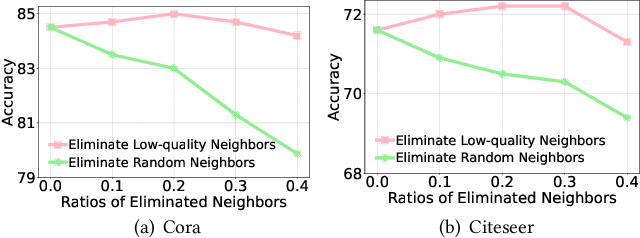
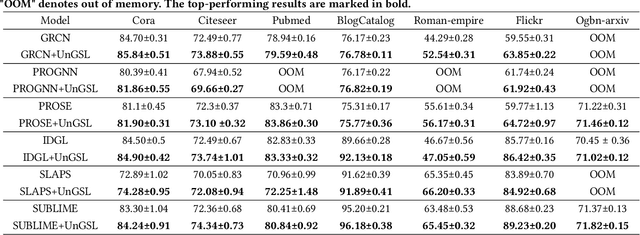
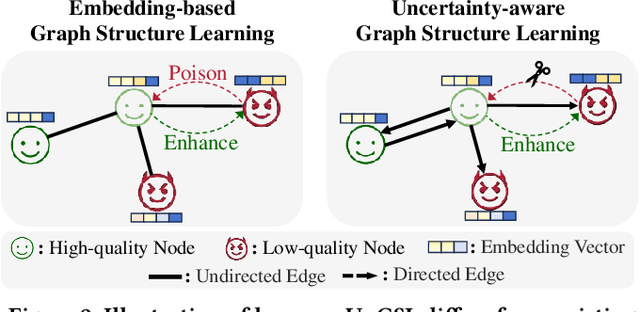
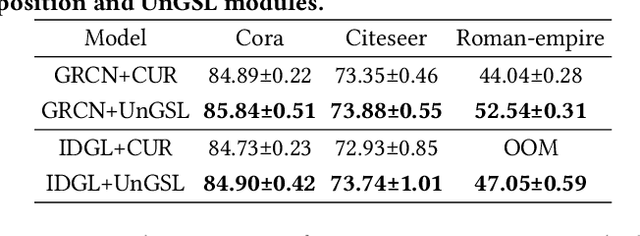
Abstract:Graph Neural Networks (GNNs) have become a prominent approach for learning from graph-structured data. However, their effectiveness can be significantly compromised when the graph structure is suboptimal. To address this issue, Graph Structure Learning (GSL) has emerged as a promising technique that refines node connections adaptively. Nevertheless, we identify two key limitations in existing GSL methods: 1) Most methods primarily focus on node similarity to construct relationships, while overlooking the quality of node information. Blindly connecting low-quality nodes and aggregating their ambiguous information can degrade the performance of other nodes. 2) The constructed graph structures are often constrained to be symmetric, which may limit the model's flexibility and effectiveness. To overcome these limitations, we propose an Uncertainty-aware Graph Structure Learning (UnGSL) strategy. UnGSL estimates the uncertainty of node information and utilizes it to adjust the strength of directional connections, where the influence of nodes with high uncertainty is adaptively reduced. Importantly, UnGSL serves as a plug-in module that can be seamlessly integrated into existing GSL methods with minimal additional computational cost. In our experiments, we implement UnGSL into six representative GSL methods, demonstrating consistent performance improvements.
Efficient Self-Supervised Video Hashing with Selective State Spaces
Dec 19, 2024



Abstract:Self-supervised video hashing (SSVH) is a practical task in video indexing and retrieval. Although Transformers are predominant in SSVH for their impressive temporal modeling capabilities, they often suffer from computational and memory inefficiencies. Drawing inspiration from Mamba, an advanced state-space model, we explore its potential in SSVH to achieve a better balance between efficacy and efficiency. We introduce S5VH, a Mamba-based video hashing model with an improved self-supervised learning paradigm. Specifically, we design bidirectional Mamba layers for both the encoder and decoder, which are effective and efficient in capturing temporal relationships thanks to the data-dependent selective scanning mechanism with linear complexity. In our learning strategy, we transform global semantics in the feature space into semantically consistent and discriminative hash centers, followed by a center alignment loss as a global learning signal. Our self-local-global (SLG) paradigm significantly improves learning efficiency, leading to faster and better convergence. Extensive experiments demonstrate S5VH's improvements over state-of-the-art methods, superior transferability, and scalable advantages in inference efficiency. Code is available at https://github.com/gimpong/AAAI25-S5VH.
Efficiently Achieving Secure Model Training and Secure Aggregation to Ensure Bidirectional Privacy-Preservation in Federated Learning
Dec 16, 2024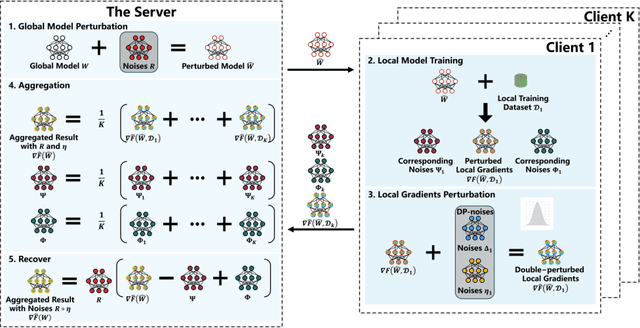
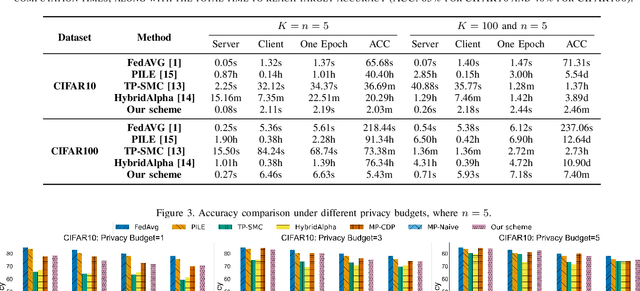


Abstract:Bidirectional privacy-preservation federated learning is crucial as both local gradients and the global model may leak privacy. However, only a few works attempt to achieve it, and they often face challenges such as excessive communication and computational overheads, or significant degradation of model accuracy, which hinders their practical applications. In this paper, we design an efficient and high-accuracy bidirectional privacy-preserving scheme for federated learning to complete secure model training and secure aggregation. To efficiently achieve bidirectional privacy, we design an efficient and accuracy-lossless model perturbation method on the server side (called $\mathbf{MP\_Server}$) that can be combined with local differential privacy (LDP) to prevent clients from accessing the model, while ensuring that the local gradients obtained on the server side satisfy LDP. Furthermore, to ensure model accuracy, we customize a distributed differential privacy mechanism on the client side (called $\mathbf{DDP\_Client}$). When combined with $\mathbf{MP\_Server}$, it ensures LDP of the local gradients, while ensuring that the aggregated result matches the accuracy of central differential privacy (CDP). Extensive experiments demonstrate that our scheme significantly outperforms state-of-the-art bidirectional privacy-preservation baselines (SOTAs) in terms of computational cost, model accuracy, and defense ability against privacy attacks. Particularly, given target accuracy, the training time of SOTAs is approximately $200$ times, or even over $1000$ times, longer than that of our scheme. When the privacy budget is set relatively small, our scheme incurs less than $6\%$ accuracy loss compared to the privacy-ignoring method, while SOTAs suffer up to $20\%$ accuracy loss. Experimental results also show that the defense capability of our scheme outperforms than SOTAs.
PSL: Rethinking and Improving Softmax Loss from Pairwise Perspective for Recommendation
Oct 31, 2024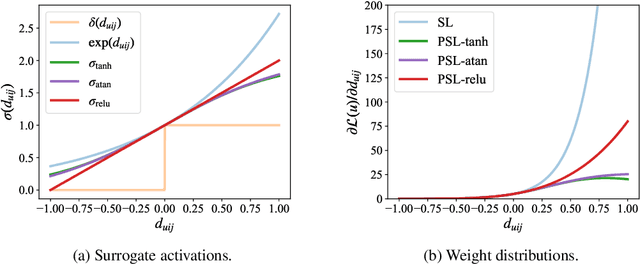
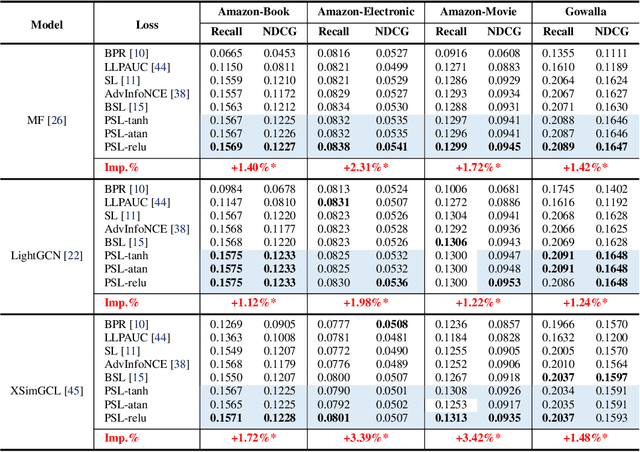
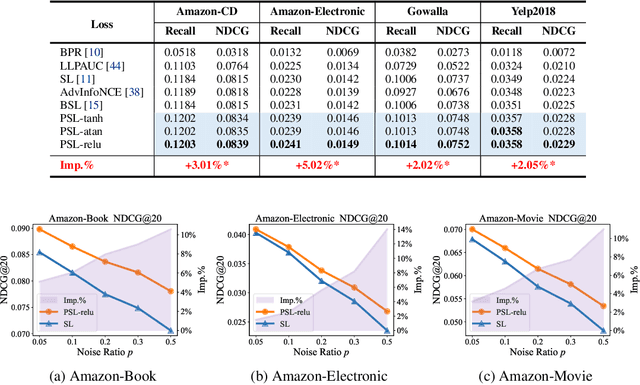

Abstract:Softmax Loss (SL) is widely applied in recommender systems (RS) and has demonstrated effectiveness. This work analyzes SL from a pairwise perspective, revealing two significant limitations: 1) the relationship between SL and conventional ranking metrics like DCG is not sufficiently tight; 2) SL is highly sensitive to false negative instances. Our analysis indicates that these limitations are primarily due to the use of the exponential function. To address these issues, this work extends SL to a new family of loss functions, termed Pairwise Softmax Loss (PSL), which replaces the exponential function in SL with other appropriate activation functions. While the revision is minimal, we highlight three merits of PSL: 1) it serves as a tighter surrogate for DCG with suitable activation functions; 2) it better balances data contributions; and 3) it acts as a specific BPR loss enhanced by Distributionally Robust Optimization (DRO). We further validate the effectiveness and robustness of PSL through empirical experiments. The code is available at https://github.com/Tiny-Snow/IR-Benchmark.
Sparse Prototype Network for Explainable Pedestrian Behavior Prediction
Oct 16, 2024



Abstract:Predicting pedestrian behavior is challenging yet crucial for applications such as autonomous driving and smart city. Recent deep learning models have achieved remarkable performance in making accurate predictions, but they fail to provide explanations of their inner workings. One reason for this problem is the multi-modal inputs. To bridge this gap, we present Sparse Prototype Network (SPN), an explainable method designed to simultaneously predict a pedestrian's future action, trajectory, and pose. SPN leverages an intermediate prototype bottleneck layer to provide sample-based explanations for its predictions. The prototypes are modality-independent, meaning that they can correspond to any modality from the input. Therefore, SPN can extend to arbitrary combinations of modalities. Regularized by mono-semanticity and clustering constraints, the prototypes learn consistent and human-understandable features and achieve state-of-the-art performance on action, trajectory and pose prediction on TITAN and PIE. Finally, we propose a metric named Top-K Mono-semanticity Scale to quantitatively evaluate the explainability. Qualitative results show the positive correlation between sparsity and explainability. Code available at https://github.com/Equinoxxxxx/SPN.
 Add to Chrome
Add to Chrome Add to Firefox
Add to Firefox Add to Edge
Add to Edge